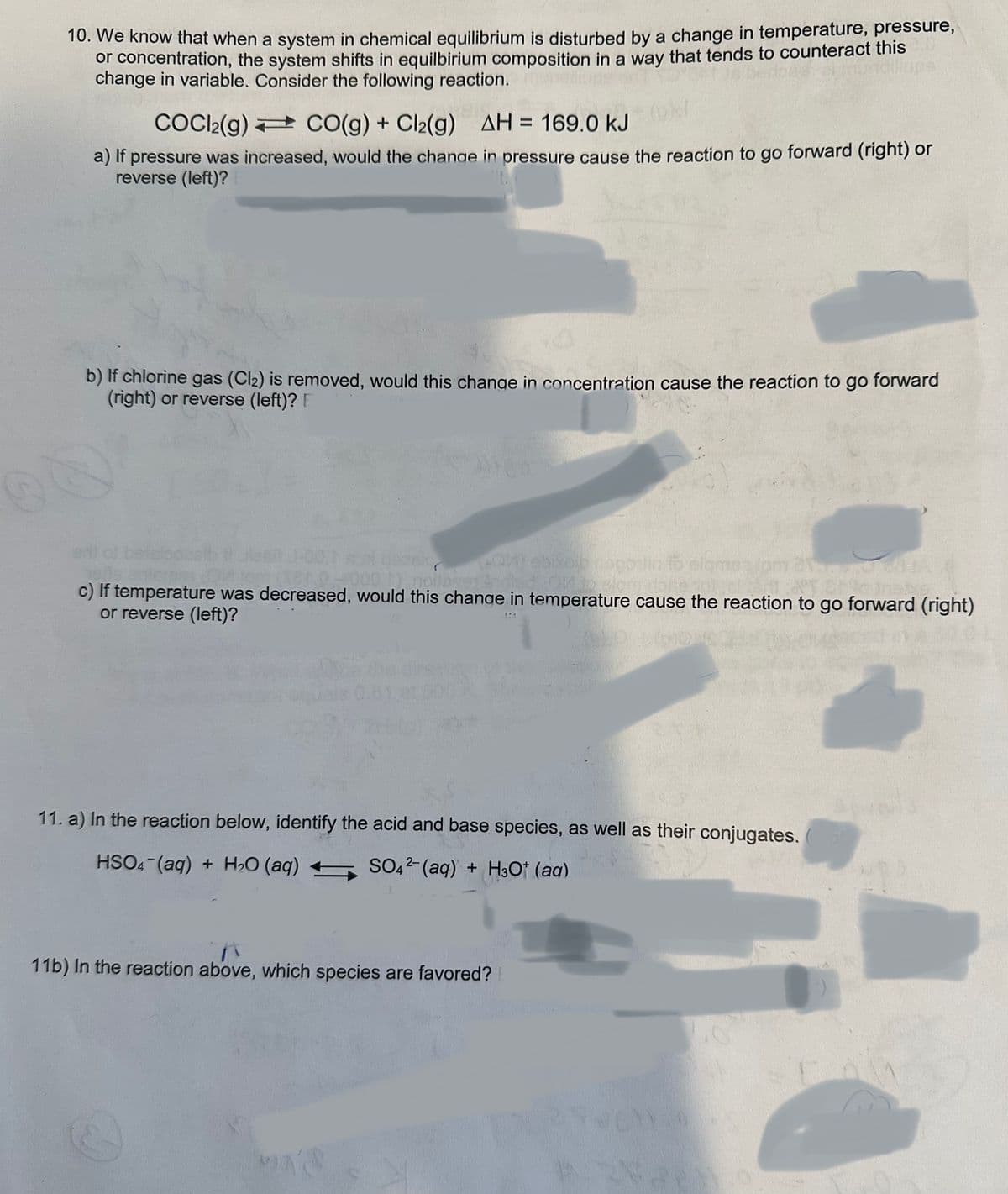10. We know that when a system in chemical equilibrium is disturbed by a change in temperature, pressure, or concentration, the system shifts in equilbirium composition in a way that tends to counteract this change in variable. Consider the following reaction. COCI2(g) CO(g) + Cl2(g) AH = 169.0 kJ a) If pressure was increased, would the change in pressure cause the reaction to go forward (right) or reverse (left)? b) If chlorine gas (Cl₂) is removed, would this change in concentration cause the reaction to go forward (right) or reverse (left)? E to elame noi Ono stors dose Sto triste c) If temperature was decreased, would this change in temperature cause the reaction to go forward (right) or reverse (left)?
10. We know that when a system in chemical equilibrium is disturbed by a change in temperature, pressure, or concentration, the system shifts in equilbirium composition in a way that tends to counteract this change in variable. Consider the following reaction. COCI2(g) CO(g) + Cl2(g) AH = 169.0 kJ a) If pressure was increased, would the change in pressure cause the reaction to go forward (right) or reverse (left)? b) If chlorine gas (Cl₂) is removed, would this change in concentration cause the reaction to go forward (right) or reverse (left)? E to elame noi Ono stors dose Sto triste c) If temperature was decreased, would this change in temperature cause the reaction to go forward (right) or reverse (left)?
Chemistry
10th Edition
ISBN:9781305957404
Author:Steven S. Zumdahl, Susan A. Zumdahl, Donald J. DeCoste
Publisher:Steven S. Zumdahl, Susan A. Zumdahl, Donald J. DeCoste
Chapter17: Spontaneity, Entropy, And Free Energy
Section: Chapter Questions
Problem 121CP: If wet silver carbonate is dried in a stream of hot air. the air must have a certain concentration...
Related questions
Question

Transcribed Image Text:10. We know that when a system in chemical equilibrium is disturbed by a change in temperature, pressure,
or concentration, the system shifts in equilbirium composition in a way that tends to counteract this
change in variable. Consider the following reaction.
lupe
COCI2(g)
CO(g) + Cl₂(g) AH = 169.0 kJ
a) If pressure was increased, would the change in pressure cause the reaction to go forward (right) or
reverse (left)?
b) If chlorine gas (Cl₂) is removed, would this change in concentration cause the reaction to go forward
(right) or reverse (left)? E
*(QM) ebixoib nappulin fo elames lom
1) noilase
c) If temperature was decreased, would this change in temperature cause the reaction to go forward (right)
or reverse (left)?
PRA
11. a) In the reaction below, identify the acid and base species, as well as their conjugates.
HSO4 (aq) + H₂O (aq)
SO42- (aq) + H3O+ (aq)
11b) In the reaction above, which species are favored?
MIK'S
Expert Solution
This question has been solved!
Explore an expertly crafted, step-by-step solution for a thorough understanding of key concepts.
Step by step
Solved in 6 steps with 6 images

Knowledge Booster
Learn more about
Need a deep-dive on the concept behind this application? Look no further. Learn more about this topic, chemistry and related others by exploring similar questions and additional content below.Recommended textbooks for you

Chemistry
Chemistry
ISBN:
9781305957404
Author:
Steven S. Zumdahl, Susan A. Zumdahl, Donald J. DeCoste
Publisher:
Cengage Learning

Chemistry: An Atoms First Approach
Chemistry
ISBN:
9781305079243
Author:
Steven S. Zumdahl, Susan A. Zumdahl
Publisher:
Cengage Learning


Chemistry
Chemistry
ISBN:
9781305957404
Author:
Steven S. Zumdahl, Susan A. Zumdahl, Donald J. DeCoste
Publisher:
Cengage Learning

Chemistry: An Atoms First Approach
Chemistry
ISBN:
9781305079243
Author:
Steven S. Zumdahl, Susan A. Zumdahl
Publisher:
Cengage Learning


Introductory Chemistry: A Foundation
Chemistry
ISBN:
9781337399425
Author:
Steven S. Zumdahl, Donald J. DeCoste
Publisher:
Cengage Learning

General Chemistry - Standalone book (MindTap Cour…
Chemistry
ISBN:
9781305580343
Author:
Steven D. Gammon, Ebbing, Darrell Ebbing, Steven D., Darrell; Gammon, Darrell Ebbing; Steven D. Gammon, Darrell D.; Gammon, Ebbing; Steven D. Gammon; Darrell
Publisher:
Cengage Learning

Chemistry: The Molecular Science
Chemistry
ISBN:
9781285199047
Author:
John W. Moore, Conrad L. Stanitski
Publisher:
Cengage Learning